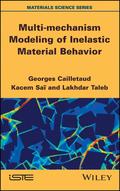Multi-mechanism Modeling of Inelastic Material Behavior

1. Edition January 2018
288 Pages, Hardcover
Wiley & Sons Ltd
Short Description
Multi-mechanism models describe the mechanical effects of metals, polymers, and geomaterials in addition to their function in developing constitutive equations. This text explains how multi-mechanism models represent monotonic and cyclic mechanical behaviors and deformation mechanisms with material parameters and internal variables. With a phenomenological focus, the book thoroughly describes the principles of plasticity, damage, creep behavior, creep plasticity interaction, and cyclic responses under proportional and non-proportional loading paths for isotropic and anisotropic materials. Various applications of the extensive experimental data qualify this book as a valued reference tool for students, material mechanics researchers, and mechanical engineers.
This book focuses on a particular class of models (namely Multi-Mechanism models) and their applications to extensive experimental data base related to different kind of materials. These models (i) are able to describe the main mechanical effects in plasticity, creep, creep/plasticity interaction, ratcheting extra-hardening under non-proportional loading (ii) provide local information (such us local stress/strain fields, damage, ....). A particular attention is paid to the identification process of material parameters. Moreover, finite element implementation of the Multi-Mechanism models is detailed.
State of the art of the multi-mechanism models
Part I : Theory
Thermodynamical framework
State variables, free energy, plastic potentials, criteria, evolution rules, including thermodynamical consistency
Model with various mechanisms and one criterion
Model with various mechanisms and various criteria
Part II: Model application
Typical stress/strain responses
Creep, plasticity/creep interaction, rate sensitivity, ratcheting, extra hardening under non proportional loading, anisotropy
Damage in multi-mechanism models, continuum damage mechanics theory, Gurson approach
Comparison with experimental data bases (Carbon steel CS1026, Austenitic stainless steel 304 and 316 for a large temperature range, Austenitic stainless steel 304, Inconel 718, N18, 2000 series Al alloy, 35NCD16, Semi-crystalline polymers, Zirconium alloy, 55NiCrMoV7, Mortar rubber aggregate).
Part III: Finite Element implementation
Numerical integration
Finite element simulation


